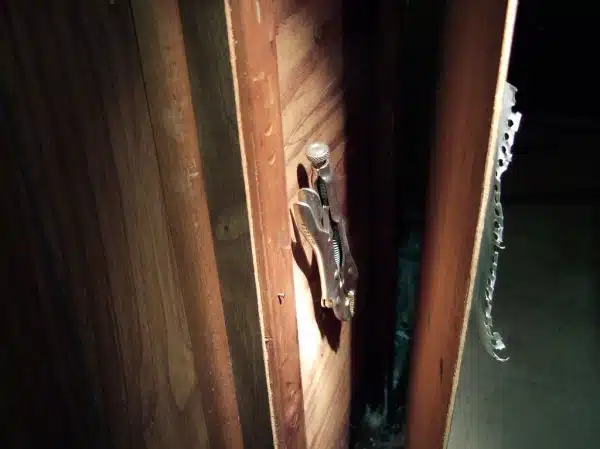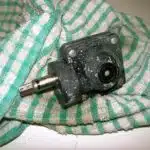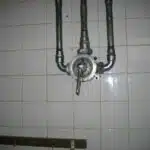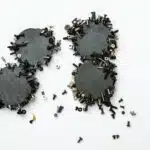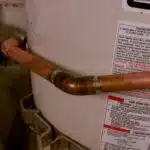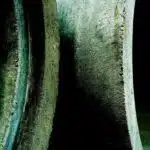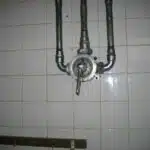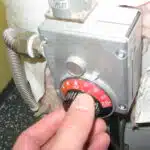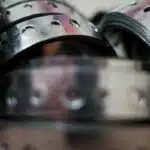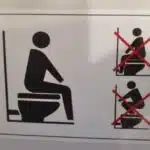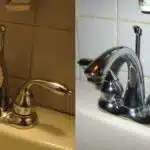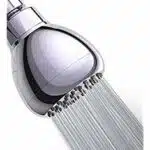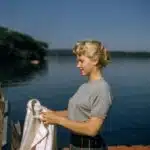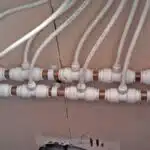As a plumbing technician, it is crucial to know how to replace a main water shutoff valve. A malfunctioning or non-functional shutoff valve can lead to significant water damage and pose serious health hazards. In addition, replacing a faulty valve can also help prevent the development of mold and other microbial growths that could be harmful to human health.
Replacing a main water shutoff valve may seem like a daunting task, but with the right tools and materials, it can be done relatively easily. By following the correct procedures, homeowners or business owners can avoid costly repair bills and ensure that their properties remain safe and comfortable for occupants. In this article, we will discuss the steps involved in replacing a main water shutoff valve in detail so that you can successfully undertake this important task with confidence.
Assessing The Need For Replacement
When it comes to replacing a main water shutoff valve, the first step is to assess whether or not it actually needs to be replaced. One common reason for replacement is age; if the valve is old and worn out, it may not function properly and could cause leaks or other problems. Another reason may be damage caused by freezing or corrosion.
Budget considerations are also an important factor when deciding whether to replace a main water shutoff valve. DIY options can be cheaper upfront, but may end up costing more in the long run if mistakes are made during installation. Hiring a professional plumber can cost more initially, but ensures that the job is done correctly and can prevent future issues.
Regardless of whether you choose to do it yourself or hire a professional, it’s important to assess the need for replacement before beginning any work. This will help ensure that you make the best decision for your budget and situation, while also preventing any unnecessary damage or complications. Once you’ve determined that replacement is necessary, the next step is gathering the necessary tools and materials.
Gathering The Necessary Tools And Materials
Before starting any plumbing work, it is essential to have all the necessary tools and materials ready. This will ensure that you do not waste time running to the store or searching for a tool while in the middle of a project. The tools needed for replacing a main water shutoff valve include an adjustable wrench, a pipe cutter, Teflon tape, and a new valve. It is also important to wear gloves and safety glasses to protect your hands and eyes.
Types of valves vary depending on their material, size, and shape. The most common materials used for valves are brass, copper, PVC, and galvanized steel. Brass is the most durable but also the most expensive. Copper is less expensive than brass but more prone to corrosion. PVC is cheap and easy to install but not very durable. Galvanized steel is also durable but can corrode over time if not maintained properly. Therefore, it is important to consider cost comparison before choosing which type of valve to use.
When purchasing a new valve, it is important to consider cost comparison of different valve materials. While some may be more expensive than others initially, they may last longer or require less maintenance in the long run. Additionally, make sure that the new valve matches the size of the old one so that it fits securely onto the pipes. A loose or ill-fitting valve can cause leaks and other problems down the line.
Now that you have gathered all necessary tools and materials for replacing your main water shutoff valve let’s move on to shutting off the water supply without causing any further damage or complications.
Shutting Off The Water Supply
Identifying the location of the water main is crucial before shutting off the water supply. The water main is the main pipe that brings in fresh water to your home, and it is important to know where it is located, so you can shut off the supply quickly in case of an emergency. If you are unsure about its location, contact your local utility provider or a licensed plumber to locate it for you.
Turning off the water supply safely is essential to avoid any damage to your plumbing system. First, turn off all appliances that require water, such as washing machines and dishwashers. Next, locate the valve that controls the water flow into your home. This valve is usually located near the meter box or where your service line enters your home. Turn the valve clockwise until it stops completely. If you cannot locate or operate the valve safely, contact a professional plumber immediately.
Shutting off the water supply can cause some inconvenience, but it will save you from costly damages due to leaks and burst pipes. As a responsible homeowner, you should make sure that everyone in your household knows how to turn off the main water valve in case of an emergency. Once you have successfully turned off the water supply, proceed to drain out any remaining water in your pipes before working on them further. This step will prevent any potential flooding when working on your plumbing system.
Draining The Water From The Pipes
As we have already learned, shutting off the water supply is a crucial first step before replacing a main water shutoff valve. Now that we have successfully cut off the water flow, it’s time to move on to draining the pipes and removing the old valve. But before we proceed further, let’s take a moment to discuss some important safety precautions.
Preventing damage should be our top priority during this process. Make sure to turn off all electrical appliances that use water, such as washing machines or dishwashers. This will help prevent any accidental leaks or flooding that could cause extensive damage to your property. Additionally, make sure to place a bucket or basin underneath the valve to catch any excess water that may still be in the pipes.
Now that you’ve taken the necessary safety measures, it’s time to remove the old water shutoff valve and install a new one. First, turn off the main water supply and drain any remaining water from the pipes. Then, follow these steps:
- Use an adjustable wrench and pliers to disconnect the valve from both ends of the pipe.
- Remove any mounting screws or bolts securing the valve in place.
- Carefully remove the old valve from its position.
With these steps completed, you can now move on to installing your new shutoff valve with confidence and ease.
Removing The Old Water Shutoff Valve
To remove the old water shutoff valve, the first step is to locate the valve and turn off the water supply. Once this is done, the next step is to remove the valve handle. The handle can usually be unscrewed by hand or with a wrench, depending on how it’s attached to the valve stem. It’s important to do this carefully so as not to damage any of the surrounding pipes or fittings.
After removing the handle, the valve body can be disassembled. To do this, use a wrench to unscrew any nuts or bolts that are holding it in place. Take note of how everything is connected so that you can reassemble everything correctly later on. Once all parts are removed, inspect them for any signs of wear and tear, rust or corrosion which may have caused your valve failure.
By following these steps, you will have successfully removed your old water shutoff valve. The next section will cover preparing your new shutoff valve for installation and installation itself.
Preparing The New Water Shutoff Valve
- In order to replace a main water shutoff valve, a plumbing technician must first gather the necessary supplies, including a wrench and a new shutoff valve.
- Next, the technician must shut off the water at the main water line.
- After the water is shut off, the technician can remove the existing valve and replace it with the new one.
- Once the new valve is in place, the technician should then turn the water back on and test the valve to ensure it is functioning correctly.
Gathering Supplies
As a plumbing technician, it is essential to gather the appropriate supplies when preparing to replace a main water shutoff valve. Choosing the right valve is crucial in ensuring that the new valve will function correctly and meet the specific needs of the household. There are various types of valves available, such as gate valves, ball valves, and globe valves. Beginners should consider using quarter-turn ball valves as they are easy to operate and reliable.
In addition to choosing the right valve, beginners must also be aware of certain tips when gathering supplies for replacing a main water shutoff valve. Firstly, it is essential to ensure that all necessary tools are available, such as pliers, adjustable wrenches, and Teflon tape. Secondly, it is recommended to have an emergency shut off tool readily accessible in case of any issues during installation. Lastly, it is vital to inspect the pipes and fittings for any leaks or damage before proceeding with the installation process.
Overall, preparing for a new water shutoff valve replacement requires careful consideration of various factors such as choosing the right valve and gathering all necessary supplies. As a plumber, providing these essential services satisfies our subconscious desire for serving others while maintaining their homes’ safety and comfort levels. Additionally, following these tips ensures that beginners can complete the installation process smoothly without encountering any significant issues along the way.
Shutting Off Water
As a plumbing technician, ensuring the timely shutoff of water is crucial when replacing a main water shutoff valve. Shutting off the water supply before commencing any installation process prevents any potential damage to the pipes and fittings that may cause leaks or bursts. It also helps to avoid accidents that may lead to injuries to both the technician and household occupants. While some homeowners may attempt DIY replacements, it is recommended to engage professional services to ensure proper installation procedures and timely shutoff.
When shutting off water, it is essential always to locate the main shut off valve, which is usually located near the water meter. Turning off this valve ceases all incoming water supply into the home, allowing for safe replacement procedures. For homes without a main shut off valve, engaging professional services becomes even more critical as they possess specialized tools that can shut off water flow at various levels within the home’s plumbing system.
In conclusion, timely shutoff of water during replacement of a main shutoff valve cannot be overstated. The importance of engaging professional services cannot be ignored as they possess specialized knowledge and tools required for successful installations while ensuring safety measures are adhered to. Whether DIY or professional replacement is chosen, locating and shutting off the main shut off valve remains an essential step in ensuring success during installation procedures and preventing potential accidents or damages in the future.
Installing The New Valve
Like a ship’s captain navigating through rough waters, the plumbing technician must ensure that all components are in proper alignment before soldering them together. This is especially important when connecting pipes to a new water shutoff valve. In this section, we will discuss proper alignment and soldering techniques to ensure the installation is secure and leak-free.
Before soldering, it is crucial to ensure that the pipes and fittings are clean and free of debris. Using emery cloth or sandpaper, remove any dirt or oxidation from the pipe ends and fittings. Next, apply flux to both the pipe end and fitting before joining them together. Proper alignment is essential for a tight bond; use a level or plumb line to ensure that the pipes are straight and flush with each other.
When soldering, it is important to heat the joint evenly while avoiding overheating any one area. Use a propane torch with a flame spreader tip for best results. Apply heat evenly around the joint until the flux begins to bubble; then touch the end of the solder wire to the seam, allowing it to flow into the joint by capillary action. Remove excess solder with a rag while taking care not to disturb or move the joint.
With proper alignment and soldering techniques, connecting pipes to a new water shutoff valve will be a straightforward process. In our next section, we will discuss how to test your installation for leaks before turning on your water supply.
Connecting The Pipes
- Before attaching the new main water shutoff valve, it is important to turn off the water supply to the old valve.
- Once the water supply has been shut off, the old valve must be disconnected and removed.
- The new main water shutoff valve should then be attached in its place, ensuring that the connections are secure.
- After the new valve is connected, it must be tested to make sure it is working correctly.
Turning Off The Old Valve
To successfully replace a main water shutoff valve, one must first turn off the old valve. This task may seem simple, but it is crucial to do it safely and correctly. It is important to note that turning off the old valve will cut off the water supply to your entire home. Therefore, it is necessary to inform all members of your household about the planned work beforehand.
To start, locate the old valve and ensure that you have access to it. Shut off the main water supply leading into your home. Next, open all faucets in your house to drain any remaining water in the pipes. This step will prevent any unnecessary damage or flooding during the replacement process.
Sometimes, an old valve may be stuck or difficult to turn off. In this situation, it is essential not to use excessive force as this could result in damaging the surrounding pipes or fixtures. Instead, try using a wrench or pliers with a gentle grip on the valve’s handle while turning it slowly. If this does not work, apply some lubricant such as WD-40 and let it sit for a few minutes before attempting again. Remember that patience is key when dealing with a stubborn old valve and seek help from a professional if needed.
Attaching The New Valve
Once the old valve has been turned off and the water supply has been drained, it’s time to attach the new valve. Before proceeding, it is important to ensure that the new valve is compatible with your existing plumbing system. Check the size and type of pipes you have and make sure that the new valve matches these specifications. Using an incompatible valve can lead to leaks, reduced water pressure, and other issues.
To attach the new valve, start by removing any debris or corrosion from the pipe’s end using sandpaper or a wire brush. Next, apply Teflon tape or pipe thread sealant to the threads of both the valve and pipe to create a proper seal. It is crucial to use proper sealing techniques to prevent leaks from occurring. After applying sealant, hand-tighten the valve onto the pipe until snug but avoid over-tightening as this could cause damage to either component.
Finally, use a wrench or pliers to tighten further if necessary while ensuring not to damage any surrounding pipes or fixtures. Turn on your main water supply and check for any leaks around the newly installed valve. If there are no signs of leakage, open all faucets in your home once again before testing them one by one for proper water flow and pressure. By following these steps carefully and correctly, you can ensure a successful replacement of your main water shutoff valve without any issues in your plumbing system.
Tightening The Fittings
After installing the new main water shutoff valve, it is important to tighten the fittings properly. This will help ensure that there are no leaks and that the water pressure is maintained. Using Teflon tape can be helpful in creating a tight seal around the fittings.
To begin, make sure all of the fittings are snugly in place. Use an adjustable wrench to tighten each fitting just enough so that it feels secure without over-tightening and risking damage to the pipes or fittings. Once all of the fittings are tightened, inspect them for any signs of leakage. If you notice any leaks, use Teflon tape to create a tight seal around the problem area.
Adjusting pressure may also be necessary after installing a new main water shutoff valve. If you notice that your home’s water pressure is too low or too high, you may need to adjust it accordingly. To do this, locate the pressure regulator and use an adjustable wrench to turn it clockwise or counterclockwise until you achieve your desired water pressure level.
With all of the fittings securely tightened and the water pressure properly adjusted, you can move on to turning on the water supply again. However, before doing so, make sure that you have inspected everything thoroughly for any leaks or other potential problems. Once everything looks good, slowly turn on the main water supply by rotating its handle in a counterclockwise direction until it is fully open again.
Turning The Water Supply Back On
Like tightening the fittings, replacing the main water shutoff valve is a crucial step in ensuring that your plumbing system is working efficiently. It’s like changing the engine of a car; it sets the tone for the entire system. This task can be daunting, but with proper guidance and attention to detail, it can be easily accomplished.
Common mistakes that people make when replacing a main water shutoff valve include not turning off the water supply completely or failing to properly seal the new valve. These mistakes can lead to leaks and other issues that will eventually require another repair. It’s important to follow safety precautions, such as wearing protective gear and using appropriate tools when handling plumbing components.
Once you have replaced the main water shutoff valve, it’s crucial to check for leaks. Turn on the water supply slowly while observing all parts of your plumbing system. If there are any signs of leakage, turn off the water supply immediately and inspect all connections for loose fittings or damaged components. Don’t ignore any signs of leakage; addressing them promptly can save you money in costly repairs down the line.
Checking For Leaks
Leaks are a common problem in plumbing systems and can lead to significant water damage and costly repairs. Identifying leaks can involve visual inspection or listening for the sound of water running and locating leaks can involve inspecting pipes and fixtures. To help ensure that leaks are located and identified, a plumbing technician should use specialized tools and techniques such as pressure gauges, leak detection fluid, and infrared thermography. Replacing a main water shutoff valve requires specialized tools and knowledge, and should only be done by a qualified plumbing technician.
Identifying Leaks
Identifying leaks is an essential step in the process of checking for leaks in a plumbing system. Common causes of leaks include damaged pipes, loose fittings, and corrosion. These issues can cause water to escape from the pipes and accumulate in areas where it shouldn’t, leading to property damage and high water bills.
Early detection techniques can help prevent these problems from escalating. One method is to look for visible signs of moisture or discoloration around fixtures such as faucets or toilets. Another technique involves checking the water meter periodically to determine whether there are any unexplained increases in usage. If you suspect that there may be a leak, it’s crucial to address the issue as soon as possible.
In summary, identifying leaks is critical for maintaining the integrity of a plumbing system. By understanding common causes and using early detection techniques, homeowners can avoid costly repairs and damages caused by water leakage. As plumbing technicians, we must educate our clients on how to check for leaks regularly and take swift action if any issues arise.
Locating Leaks
The process of checking for leaks in a plumbing system involves several essential steps. Identifying leaks is the first step, and it’s crucial to address any issues as soon as possible to prevent property damage and high water bills. After identifying leaks, the next step is to locate them accurately. This process requires specialized tools and techniques that are used by plumbing technicians.
Common causes of leaks include damaged pipes, loose fittings, and corrosion. These issues can cause water to escape from the pipes and accumulate in areas where it shouldn’t, leading to significant problems if left unchecked. Prevention tips for these issues include regular maintenance checks, proper installation techniques, and using high-quality materials.
Locating leaks requires a systemic approach that involves identifying the source of the leak accurately. Most often, this will require specialized equipment like pressure gauges or thermal imaging cameras to detect moisture levels behind walls or beneath flooring. Accurate leak detection can help homeowners save money on costly repairs and prevent further damage from occurring over time. As plumbing technicians, we must educate our clients on how to check for leaks regularly and take swift action if any issues arise.
Testing The Valve’s Functionality
To ensure that the newly installed main water shutoff valve is functioning properly, it is important to test its functionality. Testing the valve’s durability is crucial to identify possible wear and tear that may affect its performance in the long run.
One way to test the valve’s functionality is by turning on the main water supply and checking if water flows freely through all faucets and fixtures without any leaks. It is important to observe carefully for any signs of leakage around the valve or along the pipes leading up to it. Any leaks or irregularities in water flow could indicate a problem with either the valve or other parts of the plumbing system.
Another method to test the valve’s durability is by using a pressure gauge. This tool measures pressure changes in the plumbing system when opening and closing valves. By attaching it to a faucet, you can determine how much pressure is being exerted on your home’s plumbing system. A malfunctioning main water shutoff valve will show significant fluctuations in pressure readings, indicating that it needs further inspection or replacement.
- Turn on all faucets and fixtures.
- Observe carefully for any signs of leakage.
- Use a pressure gauge to measure pressure changes.
- Inspect further or replace as necessary.
Next, we will discuss cleaning up the work area after testing the valve’s functionality.
Cleaning Up The Work Area
As a plumbing technician, I understand the importance of cleaning up after completing any job. Leaving debris and tools scattered around can not only lead to safety hazards but also create a negative impression on clients. It is crucial to organize tools and minimize debris to leave the work area spotless.
Imagine walking into a kitchen with dirty dishes piled up, food scraps on the counter, and utensils lying around everywhere. It would be an unpleasant experience that would make you think twice about using that kitchen again. The same goes for a work area where plumbing repairs have been carried out. A messy space sends the wrong message about your professionalism and attention to detail.
To avoid such scenarios, it is essential to devote some time to organizing tools and minimizing debris after completing a job. All tools should be placed back in their respective toolboxes or storage areas. Any leftover materials should be disposed of properly, and all debris should be swept away. This not only creates a safe working environment but also leaves clients feeling satisfied with the quality of your work.
Moving on from cleaning up the work area, let’s talk about troubleshooting common issues that arise after replacing a main water shutoff valve.
Troubleshooting Common Issues
Common valve problems can arise in any plumbing system, including the main water shutoff valve. One of the most common issues is a leaky valve, which can be caused by worn out washers or O-rings. Another issue is a stuck valve, which can happen due to mineral buildup or corrosion. Additionally, some valves may not fully turn off the water supply even when closed.
Troubleshooting techniques for these problems involve turning off the main water supply and inspecting the valve for any visible damage or debris. If there is a leak, replacing the washers or O-rings may fix the issue. For a stuck valve, cleaning it with vinegar or replacing it entirely may be necessary. If the valve still does not fully shut off the water supply, it may require adjusting or replacement.
It is important to note that attempting to replace or repair a main water shutoff valve can be dangerous and should only be done by a licensed professional plumber. This ensures that proper safety measures are taken and that the job is completed correctly. Seeking professional help if necessary will ensure that your plumbing system remains in good working order and prevent any potential hazards from occurring.
Seeking Professional Help If Necessary
Have you exhausted all possible methods of repairing your main water shutoff valve? If so, it may be time to consider hiring professionals. While some homeowners prefer a DIY approach, seeking help from a plumbing technician can ensure that the job is done efficiently and effectively. Here are some reasons why hiring professionals is worth considering:
- Professional plumbers have the expertise and experience to handle complex plumbing issues.
- They have access to specialized tools and equipment necessary for the job.
- Professionals can provide warranties or guarantees on their work.
However, if you still prefer a DIY approach, there are steps you can take to troubleshoot common issues with your main water shutoff valve. Some of these steps include:
- Checking for leaks at the valve
- Ensuring that the valve is turned off completely
- Cleaning any debris or mineral buildup around the valve
- Tightening any loose fittings or connections
- Replacing damaged parts if necessary
It’s important to note that attempting to replace a main water shutoff valve without proper knowledge and training can result in significant damage and potential safety hazards. Therefore, it’s crucial to seek professional help if you’re unsure about how to proceed.
In summary, while DIY troubleshooting may be an option for some homeowners, seeking professional help is always recommended when dealing with complex plumbing issues such as replacing a main water shutoff valve. With their expertise and access to specialized tools, professional plumbers can ensure that the job is done safely and efficiently. However, if you do choose to attempt troubleshooting on your own, be sure to follow proper safety protocols and procedures.
Conclusion
In conclusion, replacing a main water shutoff valve can be a daunting task but with the right tools and materials, it can be done efficiently. It is important to assess the need for replacement and shut off the water supply before removing the old valve. Draining the water from the pipes is also crucial in preventing any potential damage.
Testing the functionality of the new valve is essential to ensure that it operates without any issues. Cleaning up after completing the replacement work ensures a safe and tidy work environment. Troubleshooting common problems is also necessary, but if all else fails, seeking professional help from a licensed plumber is always an option.
As they say, “an ounce of prevention is worth a pound of cure.” By regularly maintaining your plumbing system, you can prevent costly repairs in the future. As plumbing technicians, we understand that even small leaks can lead to significant problems down the line. Don’t wait until it’s too late; replace your main water shutoff valve to ensure that your plumbing system functions smoothly for years to come.
Image Credits
- “early house pictures” by dolanh (featured)

